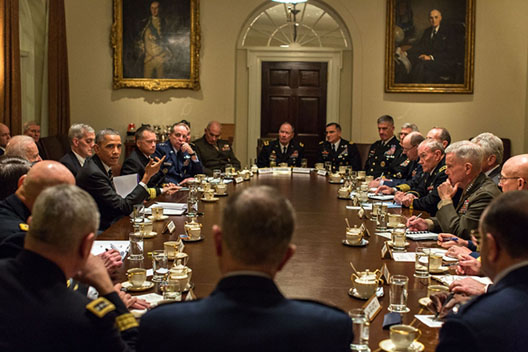 Addressing near-term security challenges and long-range global trends requires a broader approach in the execution of America’s regional national security policy, argues All Elements of National Power: Moving Toward a New Interagency Balance for US Global Engagement, a new report by the Atlantic Council’s Combatant Command Task Force. Improving interagency cooperation and integration reduces risks resulting from disjointed efforts in US global engagements and against uncertainty in a dramatically changing world. The report, chaired by General James L. Jones, Jr., USMC (Ret.), analyzes and provides recommendations on how the United States can resource and restructure to create a more balanced, forward-deployed regional approach essential to improving the integration of national instruments of power—diplomatic, informational, military, economic, and others—to advance US interests at the regional level.
Addressing near-term security challenges and long-range global trends requires a broader approach in the execution of America’s regional national security policy, argues All Elements of National Power: Moving Toward a New Interagency Balance for US Global Engagement, a new report by the Atlantic Council’s Combatant Command Task Force. Improving interagency cooperation and integration reduces risks resulting from disjointed efforts in US global engagements and against uncertainty in a dramatically changing world. The report, chaired by General James L. Jones, Jr., USMC (Ret.), analyzes and provides recommendations on how the United States can resource and restructure to create a more balanced, forward-deployed regional approach essential to improving the integration of national instruments of power—diplomatic, informational, military, economic, and others—to advance US interests at the regional level.
![]() Read the Report (PDF)
Read the Report (PDF)
American overseas presence is and will remain integral to confronting dynamic regional security challenges and military threats. Although deployed, regionally focused military forces play a key role, the execution of national security policy requires a balanced, effectively resourced interagency approach. The United States possesses tremendous strategic assets—military, economic, and political— but geopolitical events and fiscal constraints have established a requirement to adapt to new twenty-first-century realities.
Emerging powers, regional instability, individual empowerment, and political turbulence will continue to present the US national security community with new challenges. This environment also offers new opportunities to leverage American strengths to advance US interests and values abroad through the reports’ principle themes—interagency synchronization, organizational transformation, and functional and geographic efficiencies. The task force applied these tenets in detailing three options with differing degrees of integration, coordination, participation, and command relationships:
- creation of a regional interagency center that incorporates and leverages all military and civilian organizations within a single command structure;
- colocating the Department of State’s regional assistant secretary, and other civilian agencies’ regional equivalents, with the geographic combatant commander to improve coordination and unity of effort; or
- establishing a civilian deputy, or ambassador-at-large, at the geographic combatant command to serve as the coordination authority for all civilian organizations in the region.
Image: President Obama meets with Combatant Commanders. Official White House Photo/Pete Souza.
